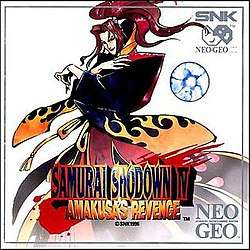Samurai Shodown IV
| Samurai Shodown IV: Amakusa's Revenge | |
|---|---|
 Neo-Geo CD cover for Samurai Shodown IV. | |
| Developer(s) | SNK |
| Publisher(s) | SNK |
| Series |
Samurai Shodown |
| Platform(s) | Arcade, Neo Geo, Sega Saturn, PlayStation |
| Release |
Arcade Neo Geo
Nintendo Switch
|
| Genre(s) | Fighting game |
| Mode(s) | Single-player, multiplayer |
| Cabinet | Upright |
| Arcade system | Neo-Geo (378 Mbit cartridge) |
| Sound | Yamaha YM2610 |
| Display | Raster, 304 x 224 pixels (Horizontal), 4096 colors |
Samurai Shodown IV: Amakusa's Revenge, also known as Samurai Spirits: Amakusa's Descent (サムライスピリッツ天草降臨 Samurai Supirittsu Amakusa Kōrin, TenSamu in short[1]) in Japan, is the fourth in SNK's flagship Samurai Shodown series of fighting games. Chronologically, it is the second and final chapter of a story between Samurai Shodown and Samurai Shodown II, with Samurai Shodown III being the first chapter.
Gameplay
Among other series changes, aerial blocking was removed entirely, as well as the switch-around move (which enabled a player to shift quickly behind the other's back), and the dodges (evade, side-step).
One can also no longer charge one's own "pow" gauge. The off-screen delivery man was omitted entirely from the game. The "CD combo" was added, wherein a player can press the C and D buttons together, triggering a strike that can be followed up by a sequence of button taps.
SNK also added a "suicide" move, wherein one's character forfeits the round. The bonus to this is that the one committing suicide will start the next round with a full "POW" gauge. Certain finishes also enable a "fatality" move in the vein of Mortal Kombat.
Characters
Some of the older characters were restored, such as Charlotte, Tam Tam and Jubei Yagyu. The entire cast of the previous game also returns, though some have been retouched to further enhance the cartoonish look.
Joining the cast are the two ninja brothers:
- Kazuki Kazama - member of the Kazama ninja clan specializing in fire jutsu, he deserts to rescue his younger sister, Hazuki, from Amakusa's clutches.
- Sogetsu Kazama - older brother to Kazuki and Hazuki who uses water jutsu; unlike Kazuki, he stays with the clan and is ordered to assassinate his brother for leaving.
Cham Cham from Samurai Shodown II also makes a playable appearance, exclusively for the PlayStation port of the game.
Reception
Reviewing the arcade version in GamePro, The Union Buster commented that Samurai Shodown IV lacks the depth of contemporaries such as Street Fighter Alpha 2 and Soul Edge, but for the same reason offers an easier pick-up-and-play experience. He was unimpressed with the two new characters but pleased with the return of those which had been dropped from the roster in Samurai Shodown III. He particularly praised the visuals, remarking that "The fighters have superb animation; several fighting stages are outright beautiful; and the special moves look awesome."[2]
The four reviewers of Electronic Gaming Monthly gave the Neo Geo home version a unanimous score of 8 out of 10, praising the high number of characters and the size of the character sprites.[3]
In a review of the Virtual Console release, Nintendo Life also gave the game an 8 out of 10, but their praise focused more on the animations, heavy challenge, and the thrilling pacing of battles, commenting, "a single slash [is] capable of turning the tide against any opponent."[4]
References
- ↑ Watsuki, Nobuhiro. "Free Talk," Rurouni Kenshin Volume 14. Viz Media. 166.
- ↑ "Hot at the Arcades: Samurai Shodown IV: Amakusa's Revenge". GamePro. No. 102. IDG. March 1997. p. 64.
- ↑ "Samurai Shodown IV Review". Electronic Gaming Monthly. No. 90. Ziff Davis. January 1997. p. 74.
- ↑ Newton, James. "Samurai Showdown IV Review". Nintendo Life. Retrieved 21 April 2014.